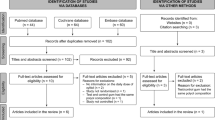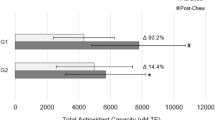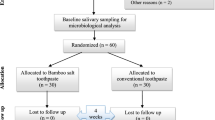Abstract
Phyllanthus emblica: (PE) fruit extract has pharmacological activity and exert anti-bacterial, anti-oxidative, anti-inflammatory and anti-cancer effects, but few study exist for evaluating its improved effects on the imbalance of oral ecology, which may contribute to series of oral diseases. In this study, an examiner-blinded, randomized, and gum-base-controlled crossover manner was conducted to evaluate the efficacy of a sugar-free chewing gum containing PE fruit extract in changing the oral microbiome. Twenty healthy young adults were randomly instructed to chew either PE gum or placebo gum. Saliva samples were collected at baseline and from 0 to 2, 2 to 5, 5 to 10, 10 to 15, and 75 to 80 min after each intervention. The following outcomes were measured: (i) salivary flow rate and pH value; (ii) total bacteria, Streptococcus mutans (S. mutans) and Porphyromonas gingivalis (P. gingivalis) counts; and (iii) volatile sulfur compound (VSC) concentrations. The results showed similar data between groups at baseline and significantly higher salivary flow rates and pH levels in the PE fruit gum group after 0–2, 2–5, and 5–10 min of chewing. Assessment of total bacteria, S. mutans, P. gingivalis, and VSC levels revealed significant differences between the PE and control gum groups at 75–80 min. No adverse effects were registered. The present finding indicated chewing gum containing PE fruit extract stimulated salivary flow and significantly reduced clinical test indexes in the short term. Chewing PE gum might be a safe means of improving oral hygiene.





Similar content being viewed by others
References
Aguirre-Zero O, Zero DT, Proskin HM (1993) Effect of chewing xylitol chewing gum on salivary flow rate and the acidogenic potential of dental plaque. Caries Res 27(1):55–59
Baliga S, Muglikar S, Kale R (2013) Salivary pH: a diagnostic biomarker. J Indian Soc Periodontol 17(4):461–465. https://doi.org/10.4103/0972-124X.118317
Dawes C, Kubieniec K (2004) The effects of prolonged gum chewing on salivary flow rate and composition. Arch Oral Biol 49(8):665–669. https://doi.org/10.1016/j.archoralbio.2004.02.007
Dawes C, Macpherson LM (1992) Effects of nine different chewing-gums and lozenges on salivary flow rate and pH. Caries Res 26(3):176–182
Gaire BP, Subedi L (2014) Phytochemistry, pharmacology and medicinal properties of Phyllanthus emblica Linn. Chin J Integr Med. https://doi.org/10.1007/s11655-014-1984-2
Haghgoo R, Afshari E, Ghanaat T, Aghazadeh S (2015) Comparing the efficacy of xylitol-containing and conventional chewing gums in reducing salivary counts of Streptococcus mutans: an in vivo study. J Int Soc Prev Commun Dent 5(Suppl 2):S112–S117. https://doi.org/10.4103/2231-0762.172947
Hossen S, Sarkar R, Mahmud S, Aziz N (2014) Medicinal potential of Phyllanthus emblica (Linn.) fruits extracts: biological and pharmacological activities. Br J Pharm Res 4:1486–1499
Hu DY, Hong X, Li X (2011) Oral health in China–trends and challenges. Int J Oral Sci 3(1):7–12. https://doi.org/10.4248/IJOS11006
Islam T, Azad A, Akter S, Datta S (2012) Antimicrobial activity of medicinal plants on Streptococcus mutans, a causing agent of dental caries. Int J Eng Res Technol 1(10):1–6
Karami-Nogourani M, Kowsari-Isfahan R, Hosseini-Beheshti M (2011) The effect of chewing gum’s flavor on salivary flow rate and pH. Dent Res J 8(Suppl 1):S71–S75
Karami Nogourani M, Janghorbani M, Kowsari Isfahan R, Hosseini Beheshti M (2012) Effects of chewing different flavored gums on salivary flow rate and pH. Int J Dent 2012:569327. https://doi.org/10.1155/2012/569327
Kilian M, Chapple IL, Hannig M, Marsh PD, Meuric V, Pedersen AM, Tonetti MS, Wade WG, Zaura E (2016) The oral microbiome—an update for oral healthcare professionals. Br Dent J 221(10):657–666. https://doi.org/10.1038/sj.bdj.2016.865
Krishnaveni M, Mirunalini S (2010) Therapeutic potential of Phyllanthus emblica (amla): the ayurvedic wonder. J Basic Clin Physiol Pharmacol 21(1):93–105
Llena-Puy C (2006) The role of saliva in maintaining oral health and as an aid to diagnosis. Med Oral Patol Oral Cir Bucal 11(5):E449–E455
Mahata S, Pandey A, Shukla S, Tyagi A, Husain SA, Das BC, Bharti AC (2013) Anticancer activity of Phyllanthus emblica Linn. (Indian gooseberry): inhibition of transcription factor AP-1 and HPV gene expression in cervical cancer cells. Nutr Cancer 65(Suppl 1):88–97. https://doi.org/10.1080/01635581.2013.785008
Mayachiew P, Devahastin S (2008) Antimicrobial and antioxidant activities of Indian gooseberry and galangal extracts. LWT-Food Sci Technol 41(7):1153–1159
Mayanagi G, Igarashi K, Washio J, Takahashi N (2017) pH Response and tooth surface solubility at the tooth/bacteria interface. Caries Res 51(2):160–166. https://doi.org/10.1159/000454781
Meng Y, Liu XN, Zheng SG (2017) Status and analysis of oral disease burden: comparison of the domestic and overseas data. Zhonghua Kou Qiang Yi Xue Za Zhi 52(6):386–389. https://doi.org/10.3760/cma.j.issn.1002-0098.2017.06.014
Muniz FW, Friedrich SA, Silveira CF, Rosing CK (2017) The impact of chewing gum on halitosis parameters: a systematic review. J Breath Res 11(1):014001. https://doi.org/10.1088/1752-7163/aa5cc2
Okahashi N, Sasakawa C, Yoshikawa M, Hamada S, Koga T (1989) Molecular characterization of a surface protein antigen gene from serotype c Streptococcus mutans, implicated in dental caries. Mol Microbiol 3(5):673–678
Pientaweeratch S, Panapisal V, Tansirikongkol A (2016) Antioxidant, anti-collagenase and anti-elastase activities of Phyllanthus emblica, Manilkara zapota and silymarin: an in vitro comparative study for anti-aging applications. Pharm Biol 54(9):1865–1872. https://doi.org/10.3109/13880209.2015.1133658
Rösing C, Gomes S, Bassani D, Oppermann R (2009) Effect of chewing gums on the production of volatile sulfur compounds (VSC) in vivo. Acta Odontol Latinoam 22(1):11–14
Rahman S, Akbor MM, Howlader A, Jabbar A (2009) Antimicrobial and cytotoxic activity of the alkaloids of Amlaki (Emblica officinalis). Pak J Biol Sci 12(16):1152–1155
Rahmatullah M, Hossan N, Rashid MH, Rahman T, Chowdhury MH, Jahan R (2009) A survey of medicinal plants in two areas of Dinajpur district, Bangladesh including plants which can be used as functional foods. Am Eurasian J Sustain Agric 3(4):862–876
Rattanasena P (2012) Antioxidant and antibacterial activities of vegetables and fruits commonly consumed in Thailand. Pak J Biol Sci 15(18):877–882
Reingewirtz Y, Girault O, Reingewirtz N, Senger B, Tenenbaum H (1999) Mechanical effects and volatile sulfur compound-reducing effects of chewing gums: comparison between test and base gums and a control group. Quintessence Int 30(5):319–323
Ribelles Llop M, Guinot Jimeno F, Mayne Acien R, Bellet Dalmau LJ (2010) Effects of xylitol chewing gum on salivary flow rate, pH, buffering capacity and presence of Streptococcus mutans in saliva. Eur J Paediatr Dent 11(1):9–14
Slots J, Ting M (1999) Actinobacillus actinomycetemcomitans and Porphyromonas gingivalis in human periodontal disease: occurrence and treatment. Periodontol 2000 20:82–121
Struzycka I (2014) The oral microbiome in dental caries. Pol J Microbiol 63(2):127–135
Tanaka M, Toe M, Nagata H, Ojima M, Kuboniwa M, Shimizu K, Osawa K, Shizukuishi S (2010) Effect of eucalyptus-extract chewing gum on oral malodor: a double-masked, randomized trial. J Periodontol 81(11):1564–1571. https://doi.org/10.1902/jop.2010.100249
Tonzetich J (1971) Direct gas chromatographic analysis of sulphur compounds in mouth air in man. Arch Oral Biol 16(6):587–597
Tonzetich J, Eigen E, King W, Weiss S (1967) Volatility as a factor in the inability of certain amines and indole to increase the odour of saliva. Arch Oral Biol 12(10):1167–1175
Wang CC, Yuan JR, Wang CF, Yang N, Chen J, Liu D, Song J, Feng L, Tan XB, Jia XB (2016) Anti-inflammatory effects of Phyllanthus emblica l on benzopyrene-induced precancerous lung lesion by regulating the IL-1beta/miR-101/Lin28B signaling pathway. Integr Cancer Ther. https://doi.org/10.1177/1534735416659358
Xu M, Zhu HT, Cheng RR, Wang D, Yang CR, Tanaka T, Kouno I, Zhang YJ (2016) Antioxidant and hyaluronidase inhibitory activities of diverse phenolics in Phyllanthus emblica. Nat Prod Res. https://doi.org/10.1080/14786419.2015.1137573
Yoshida A, Suzuki N, Nakano Y, Kawada M, Oho T, Koga T (2003) Development of a 5′ nuclease-based real-time pcr assay for quantitative detection of cariogenic dental pathogens Streptococcus mutans and Streptococcus sobrinus. J Clin Microbiol 41(9):4438–4441. https://doi.org/10.1128/jcm.41.9.4438-4441.2003
Funding
This study was funded by China Tobacco Yunnan Industrial Co., Ltd Science and Technology Project (Grant Numbers 2017JC05 and 2015JC02).
Author information
Authors and Affiliations
Contributions
JY and QG conceived and designed the experiments; HH contributed significantly to analysis and manuscript preparation; YG and QM performed the experiments; XL proofread the manuscript.
Corresponding author
Ethics declarations
Conflict of interest
The authors declare that they have no conflict of interest.
Rights and permissions
About this article
Cite this article
Gao, Q., Li, X., Huang, H. et al. The Efficacy of a Chewing Gum Containing Phyllanthus emblica Fruit Extract in Improving Oral Health. Curr Microbiol 75, 604–610 (2018). https://doi.org/10.1007/s00284-017-1423-7
Received:
Accepted:
Published:
Issue Date:
DOI: https://doi.org/10.1007/s00284-017-1423-7




